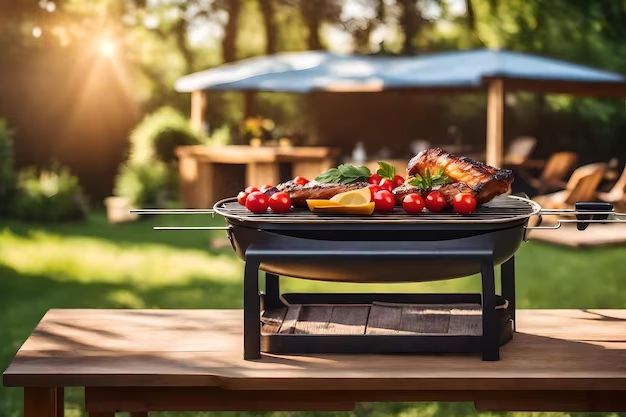Page Contents
Quick Answer
It is generally not recommended to place a hot grill directly on a plastic table. The heat from the grill can melt or warp plastic tables that are not specifically designed for high heat. A better option is to use a grill mat or pad in between the grill and table to protect the surface. You can also place the grill on a heat-resistant table made of metal, stone, or ceramic. Take precautions to ensure the plastic table legs do not melt from the grill’s heat being too close.
Factors to Consider
There are several factors to consider when deciding whether to put your grill on a plastic table:
Type of Plastic
Not all plastics are created equal. High-density polyethylene (HDPE) and polypropylene plastics can withstand higher temperatures than standard plastic table materials like polycarbonate. HDPE plastic furniture is a good option if you want to grill on a plastic surface.
Standard plastic patio tables are typically not engineered to withstand prolonged direct high heat from grills. The plastic polymers can warp, bend, melt, burn, or leach chemicals when exposed to the grill’s heat over 200°F.
Distance from Heat Source
The further away the plastic surface is from the direct heat source, the less chance of damage. Allow for several inches of clearance between the bottom of the grill and the table surface. This allows more heat dissipation.
Keep the grill towards the center of the table instead of the edge to prevent melting from intense concentrated heat. Plastic table edges and legs are thinner and more vulnerable to heat damage.
Temperature and Duration
Lower temperature grills like portable electric grills may be less risky than intense 500°F+ charcoal or gas grills. The longer the grill is left on, the more heat is transferred to the plastic, increasing melt risks. Intermittent grilling for short periods is preferable to prolonged heat exposure.
Let the grill adequately cool before touching plastic surfaces. Post-grilling heat retained in the grill can still melt plastics upon contact.
Ventilation
Grills produce immense radiant heat. Allowing airflow under and around the grill prevents a heat buildup that could warp or melt the plastic. Elevate the grill on something non-flammable to allow ventilation. Leave a few inches of buffer space around the edges.
Flammability
Plastic is flammable at certain temperatures. Melting plastics can ignite, drip, and spread fire. Be cautious of potential flare-ups from fatty foods overheating. Keep a fire extinguisher on hand. Avoid grilling on plastic tables on dry, windy days when wildfires are a concern.
Weight and Stability
Ensure the plastic table can handle the weight of the grill plus foods. The grill weight may weaken, bend, or break cheaper plastic tables. Heat could further compromise the integrity of the plastic.
Avoid placing heavy grills near the edge where leverage increases the chance of buckling. Stability is crucial to avoid tipping accidents or burns. Secure portable grills on plastic surfaces with braces or tie-downs.
Grill Placement Tips
If you decide to go ahead with grilling on a plastic table, follow these tips:
– Place a grill mat, welding blanket, or sheet of aluminum foil between the grill and plastic surface. This acts as a heat shield.
– Choose a high-quality HDPE or polypropylene table rated for outdoor and high heat use. Avoid cheap plastic furniture.
– Allow for plenty of ventilation around and under the grill.
– Use a smaller portable grill rather than a huge backyard grill.
– Monitor grill temperature and don’t let it exceed 400°F when on plastic.
– Avoid placing on table edges where heat concentrates.
– Periodically check for signs of melting like soft spots, indents, warping, or sagging.
– Never leave the hot grill unattended on the plastic table.
– Keep children and pets safely away as the plastic could melt.
Safer Alternative Surfaces
For worry-free grilling, use non-flammable, heat-resistant surfaces:
Metal
Stainless steel, aluminum, and other metal tables conduct heat well and typically won’t be damaged by grills. Just ensure table legs and fasteners aren’t plastic or resin that could melt.
Stone
Durable stone materials like granite, marble, and slate withstand up to 1,800°F. Avoid porous surfaces that may stain or absorb grease drippings. Seal the stone for easier cleaning.
Ceramic
Ceramic tables provide an affordable and stylish grilling surface. Unglazed ceramic handles up to 2,000°F. The porcelain coating on enameled steel grills helps prevent rusting.
Concrete
Concrete’s thermal mass helps resist heat damage. Non-combustible precast concrete tables are ideal for grilling. Avoid wood aggregate surfaces. Seal concrete to prevent staining and grease penetration.
Brick or Masonry
Like concrete, brick and masonry materials are naturally fire-resistant. Use a tabletop grill mat to prevent scratches or stains. Clean spills promptly to avoid grease pooling in cracks.
Conclusion
While plastic tables may seem like a convenient outdoor grilling surface, take caution. Prolonged high heat exposure can warp, melt, or ignite plastic. For safety, opt for grill-friendly surfaces like metal, stone, ceramic, concrete, or brick instead of plastic furniture. Or use protection like grill mats if you must use a plastic patio table. Supervise the grill at all times, allow for ventilation, control temperature, and limit grilling duration to prevent plastic damage when grills are placed on plastic surfaces. With extra care and prevention methods, you can successfully use your plastic patio table for occasional grilling.
